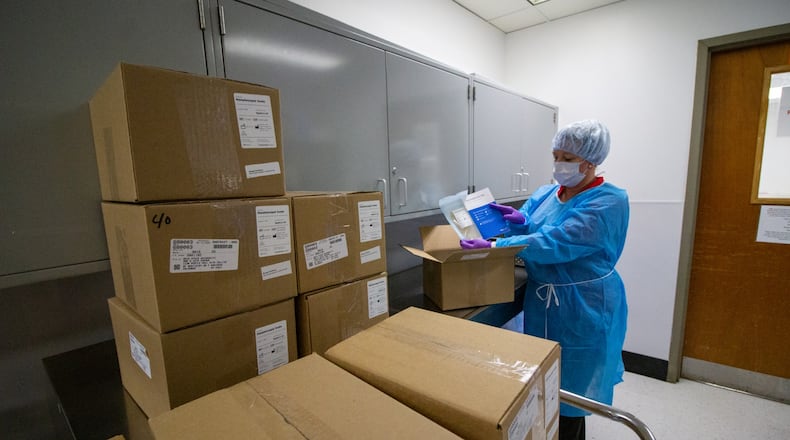Earlier this week, business leaders on President Donald Trump’s advisory council on restarting the economy urged for more screening for the virus, saying the economy can’t rebound until people feel safe enough to come out.
One of the layers to the challenge of scaling up testing is a shortage of both the swabs to collect samples and the sterile solution needed to transport the swabs for testing.
“Health systems worldwide have struggled because of the critical shortage of test kit components,” Ohio Gov. Mike DeWine said Wednesday.
DeWine said a rapidly assembled team of Ohio State University researchers recognized the shortage and created an in-house “recipe” to make the crucial liquid transport medium.
In addition, the Ohio State University Wexner Medical Center and Ohio State’s colleges of medicine, engineering and dentistry, along with the Center for Design and Manufacturing Excellence, Infectious Diseases Institute, and Institute for Materials Research, collaborated with a national consortium that rapidly deployed a design and testing program for 3D-printed testing swabs.
Ohio State is part of the academic-industry-government consortium led by Harvard, the U.S. Army, and the University of South Florida that designed the swabs, DeWine said.
Ohio State teams are working with 3D-manufacturing companies, including FormLabs Inc. in Toledo, and academic institutions across the state to produce these swabs and swab kits in significant amounts, according to DeWine.
The first order of 15,000 3D-printed swabs will be delivered to Ohio State, with a target of 200,000 swabs and swab kits to be shared with the Ohio Department of Health and hospital systems in Ohio, allowing more people to be tested by the end of April, DeWine said.
Part of why more testing is so critical — and why this particular coronavirus has been so hard to respond to — is that people might be infectious but not know and spread the virus in the community.
Identifying and isolating sick people and tracing the close contacts of sick people is a central part of breaking the chain of transmission.
“As the governor begins to look at all the criteria for re-opening this state, he will be looking at public health indicators … adequate capacity for testing, adequate personal protective equipment, adequate capacity in our hospitals, being able to identify ill individuals, isolate them, quarantine close contacts and having a sustained reduction over time in confirmed in probable cases,” Montgomery County Health Commissioner Jeff Cooper said.
The drive-through testing sites in Dayton and other areas typically involve a swab collecting a sample from the back of the throat and nose and sent to one of the major labs, a hospital or a state lab. Point-of-care testing options have been coming to market that can get quicker results and be used in an office setting.
Abbott, which is the largest maker of these tests currently, said it is currently manufacturing 50,000 tests per day and said it plans to increase ID NOW manufacturing capacity to 2 million tests a month by June. It’s working to expand even beyond that.
Yale economist Zack Cooper said Thursday in an online Q&A that the federal government could increase testing by setting high reimbursement rates for COVID-19 tests. That would give certainty to firms to invest in order to produce millions of more tests. He said the federal government could also increase testing by paying for all the tests that are provided.
“Third, the federal government should be pulling out all the stops to guarantee that we have the supplies necessary — swabs, reagents, etc. — to ramp-up testing. This might involve paying directly for firms’ start-up costs, or invoking the Defense Production Act,” Cooper said.
Cooper, who has been advising policymakers and legislators during the COVID-19 pandemic, said some have framed reopening as a debate between economists and public health academics.
“This couldn’t be further from the truth,” he said What we’ve been arguing is that precisely because the economic costs of social distancing and COVID-19 are so high, we need to be spending way more on ramping-up testing, contact tracing, masks, and on the medical innovation that will support the reopening of the economy.”
About the Author
